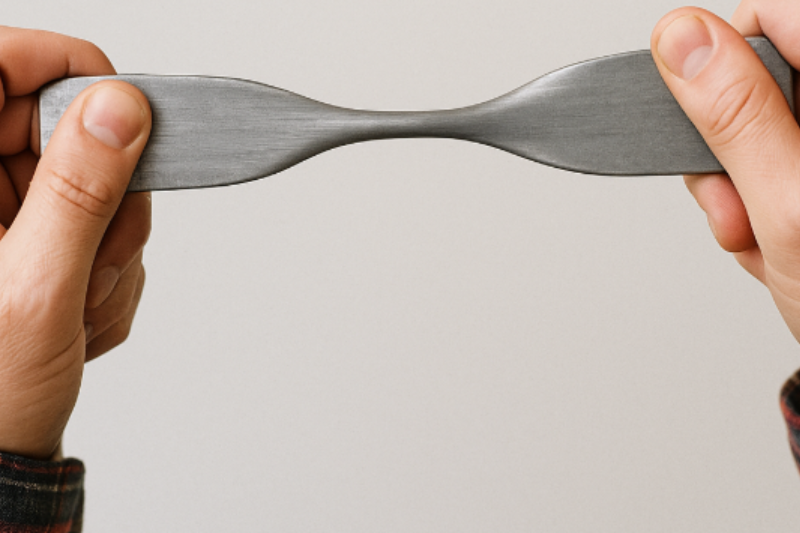Ductility: Definition, Importance, Ductile Materials Examples
Ductility is one of the most important physical properties in engineering and manufacturing. It describes how much a material can stretch or deform under tensile stress without breaking, which directly affects forming, machining, and shaping. In industries such as CNC machining, sheet metal fabrication, and 3D printing in Singapore, understanding ductility allows you to choose materials that deliver strength, flexibility, and long-term performance.
When you compare plastics, resins, powders, and metals, having a clear understanding of 3D printing materials helps you select the best material for your printing method.
What is Ductility?
Ductility is the ability of a material to deform plastically under tensile stress without fracturing. Engineers measure ductility using two main metrics such as Percent Elongation at Break (%EL) and Percent Reduction of Area (%RA).
A material with high ductility can be drawn into a wire, bent, or shaped without cracking. It is an essential property in manufacturing, automotive, aerospace, and construction applications.

Importance of Ductility in Engineering & Fabrication
Ductility matters because it determines how a material behaves when subjected to forces during manufacturing, assembly, and service life. In practice, ductility affects everything from design safety to manufacturing cost and product reliability. Here’s why it’s so critical:
Safe Forming and Shaping Without Cracks
When engineers bend, stamp, draw, or roll sheet metals, ductility ensures the material can deform without cracking. This is essential for
- Sheet Metal Fabrication of housings, enclosures, and brackets.
- Aluminium Sheet Fabrication where lightweight panels must maintain integrity under shaping.
With higher ductility, manufacturers can achieve tighter bends, deeper draws, and more complex forms with fewer production defects.
Withstanding Real-World Loads and Impacts
Ductile materials can absorb energy under shock or stress. Instead of fracturing suddenly (as brittle materials do), ductile metals deform and “give,” which prevents catastrophic failure. This property is vital for
- Structural components in buildings and bridges.
- Automotive and aerospace parts subject to vibration and impact.
- Precision components from CNC Machining that must tolerate loads without cracking.
Enhancing Reliability and Service Life
A ductile part can yield locally around stress concentrations, distributing load more evenly and reducing the chance of sudden breakage. This directly improves product reliability, especially where temperature fluctuations or cyclic loads are common.
Supporting Welding, Joining, and Repairs
Welded joints, rivets, or fasteners often create localized stresses. Ductile materials tolerate these stresses better, making fabrication and maintenance easier. In metal fabrication, ductility allows for post-weld adjustments or forming operations without damaging the part.
Enabling Prototyping and Iteration in 3D Printing
When using SLA 3D printing or FDM 3D printing, ductile polymers or metal-filled filaments help you test functional prototypes under real-world conditions. Flexible materials let you iterate designs faster and with less risk of breakage.
Meeting Regulatory and Safety Standards
Engineering codes often require materials with a minimum level of ductility to ensure fail-safe behavior. For instance, building codes, piping standards, and aerospace specifications often set elongation thresholds. By selecting ductile materials, manufacturers meet compliance standards and reduce liability.
Reducing Production Cost and Waste
Higher ductility often translates to fewer rejects and less material waste during forming, bending, or drawing operations. This improves yield and reduces cost per unit, especially in high-volume production such as plastic injection molding or sheet metal work.
Examples of Ductile Materials
Ductile materials are substances that can stretch or deform under tensile stress without breaking. Common examples of ductile materials include metals like copper, aluminium, and mild steel, as well as certain polymers such as polyethylene.
Examples of Ductile Materials:
- Copper – highly ductile and used for wiring
- Aluminium – lightweight and formable for sheet metal parts
- Mild/Low-Carbon Steel – good elongation for fabrication
- Silver – soft and easily drawn into wires
- Gold and Platinum – among the most ductile natural metals
- Stainless Steel (selected grades) – high elongation for corrosion-resistant components
- Polyethylene (selected thermoplastics) – flexible, high elongation at break
Is Ductility a Physical or Chemical Property?
Ductility is a physical (mechanical) property. It describes how a material can stretch or deform under tensile stress without breaking, which does not involve any change in the material’s chemical composition. In other words, ductility measures behavior under force, not a chemical reaction.
Is Ductile a Metal or Nonmetal?
Ductility is not limited to metals, but most ductile materials are metals. In other words, ductile describes a property, not a category. Metals such as copper, aluminium, and mild steel are highly ductile, while certain non-metallic polymers (like polyethylene) can also show ductile behavior under stress.
Ductility vs. Malleability (Key Difference)
Ductility measures how a material stretches under tensile (pulling) stress, while malleability measures how a material deforms under compressive (hammering or rolling) stress.
Conclusion
Understanding ductility and how it affects forming, machining, and 3D printing is crucial for creating safe, durable, and cost-effective products. By selecting materials with the right balance of ductility and strength, engineers can achieve more complex designs, reduce production risks, and improve performance across industries.
At The Monster Builder, we bring deep expertise in 3D printing (SLA and FDM), and plastic injection molding. Our team helps you choose the best ductile materials for your application, ensuring parts are fabricated to the highest standards and delivered on time in Singapore.



